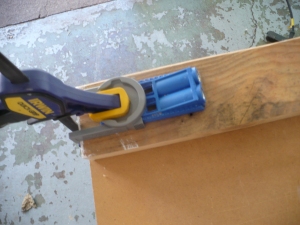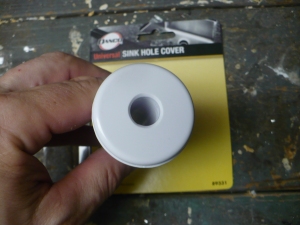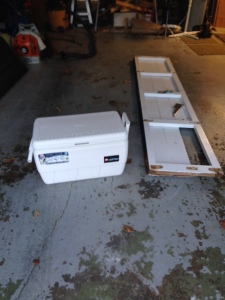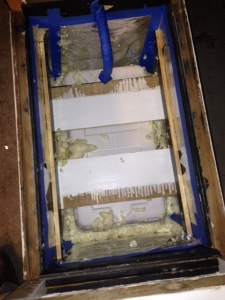Introduction:
The fun of these projects is in the problem solving – and I found a whole lot of fun in this build. I got inspired to make another, different cooler. This is intended to be an adventure log, not an instruction manual – sharing challenges and conclusions. I do not go into specific details on how to build this cooler, but offer tips and tricks along the way so you can have your own adventure.
I started with a dumpster diving expedition and found these items. This cooler stand may need to live outside so I was looking for rain resistant items.

In my last project, using a found wooden garage door drove the narrative of the entire project. It was easy to decide on height and width of the panels because they were dictated by the size of the existing panels. The dimensions of the door aligned well with the cooler size, the door siding was just the right size to cut for the top. The objective became fashioning everything on the cooler from some piece of the garage door. Using hinges, brackets, and all of the fittings without purchasing new material. On this build I gathered the roofing, some metal trim, a couple of beat-up 2X pieces of lumber and a couple of pallets. I have admired the stands that use pallets for their rustic look and feel and I was determined to make another project that is “upconfigured”.
I began taking the pallets apart and figured out that there are pallets, and then there are real pallets. These pallets were one-time use pine pallets for paving stones. Spiral nails are incredibly good at holding wood together, and when coupled with pine boards, deconstruction leaves you with piles of shattered boards. I ended up cutting nails to disassemble the pallets and realized that they were not going to be a great source of material.


I found that the wavy red material is a kind of shingle – perfect for a roof, but probably not tough enough to be mounted vertical, and would be difficult to attach in any configuration of a cooler. So, overall, material gathering didn’t turn out so well. If I was on an HGTV show the pressure to finish in a day would be high drama given that my materials were not completely suitable and we would go to a commercial break.
So I moved to “Plan B”. Build a solid frame out of the 2X lumber and decorate with the pallet wood. I sketched up a design and got started. As this stand might live outside, I remember back to all the Norm Abram “This Old House” lessons I have learned. Water is the enemy, and you should make sure not to leave a place for it to stand. All of the cross members would need to be sloped so that the water would shed. I ripped long pieces with a 10 degree angle on the table saw.



Since these pieces would be fastened and glued together I prime all the surfaces so that the nooks and crannies would be protected from any water intrusion.
I have been reading about how great the Kreg pocket hole cutter works on this kind of project, so I hit Amazon and gave it a try. A couple tips for using this device. 1) practice on a couple of scraps, 2) buy more clamps, 3) clamp everything exactly how you want it and then drill and glue and screw it together – all while clamped. I had everything lined up on the first attempt but the boards drifted out of alignment when the screw grabbed. This is a good application for pocket holes because there are redundant attachment points for these frames. I used Gorilla glue throughout to ensure good adhesion in the weather.



Once these frame members were completed I used the same lag bolt structure that I used on the last cooler to attach the front to the sides. This is blasphemy to my woodworking friends as mortise and tenons are the best for this construction (maybe the next cooler project), but the look of the lag bolts worked on this construction for some reason.

Now I had a sturdy frame for the cooler stand and I primed all of the surfaces – but my plan was not working. All the work to pull pallets together did not yield enough wood to do all four sides and a top. So, time to pivot the project again. I got with my top consultant and we discussed that the recipient of this cooler likes metal – so some sort of metal decoration on the front and back would be a good idea leaving the sides with the pallet pieces. Off to Lowes.

The side panels would be made of pallet planks – so I cleaned them up a bit and realized that they did not have the weathered look I was seeking. I stapled them to the inside of the end frames to see how it would look.



I experimented with some different colorations. I was shooting for a weathered gray look like you find on wood at the beach. The multi-shade treatment turned out pretty well.

For the top ridge around the cooler I took wide boards from the pallet and made a butt-seamed frame that will lay on the top. This seemed more stable than some of the plans online that run board across and then cut out the cooler hole. I think this will also be more stable than the boards joined at 45 degree angles since pallet boards are pretty unstable. The pocket holes are placed toward the middle since the frame will be glued and screwed to the base around the edges.

I like to build in the cooler permanently. I figure that I built it from scratch, I can cut it out and replace it from scratch. I wanted a narrow gap that could be caulked shut. I traced the cooler rim and then used the jigsaw to get a hole with a tight fit. After cutting I painted the top, bottom and the inside edges of the hole for the cooler.

The Lid.
The top of this particular cooler is going to need to be weatherproof. After walking many aisles at Lowes, I formed a plan. I laid out the frame structure using the pallet parts for the frame. I found some galvanized HVAC metal panels designed to clip together in a 2X4 wall. Two of these spanning the top would make a perfect size top. The ends needed to be trimmed, and the center connection would need to be inserted into a cut in the frame – notice the notch above the word “PAVESTONE”



If you choose to use these metal panels, make sure that you center the panels on your top length-wise and cut both the ends off so that the pattern of the metal grid is symmetrical (this one is not quite centered). I used a metal ruler and piece of wood to make a metal bending brake. The clamps hold the ruler and board together and then you bend, making a crisp seam the whole length of the metal.

I flipped the panels face down and pop-riveted them together and then taped the seam. More photos of the top later.
For the drain, I found that a copper pipe would fit into the inside of my spigot so I brazed it in. This extension allows tubing to be clamped on later. I drilled a hole in the frame and threaded the galvanized reducer shown below into the wood, and then threaded the spigot into the reducer’s threads.


I purchased a cooler without a drain and used the sink hole plug as a nice trim for my drain. A bottom drain allows all the water out without having to tilt the whole stand.


Some tubing and a couple of pipe clamps and the drain is in place.

I neglected to photograph the front and back panel installation because it was so quick. Again in the HVAC section, there are flat metal sheets in various sizes. I cut them to size and screwed them to the inside of the front and back frames. As you can see here, I covered them on the inside with some scrap plywood to back them.
To hold the cooler, I pushed it up into place and nailed in some cleats attached to a cross member to hold the weight of the cooler. I pre-drilled the support so the drain would pass through. I flipped the cooler and covered the pallet ends with aluminium foil on the inside so that the foam would not expand between the boards and show. If you dispense Great Stuff slowly it expands a great deal more.

The cooler is now foamed into place, Time for exterior paint, wheels, a shelf, and other odds and ends.



The front and back metal panels are magnetic so some decorative magnets only made sense. Hot glue and bottle caps.





No ice in it yet, but it is certainly beer time.
All told this project took about 2 days of construction work including painting. I learned a number of tricks that will come in handy in future cooler building or other projects. I hope my sister enjoys this cooler. Try building one yourself – it is very gratifying to pull that lid back reach into an icy bath of bottles and pry the lid off with the built-in opener (even if it is a twist off!) Good luck.
Stay tuned – subscribe to this channel for different project ideas.



























